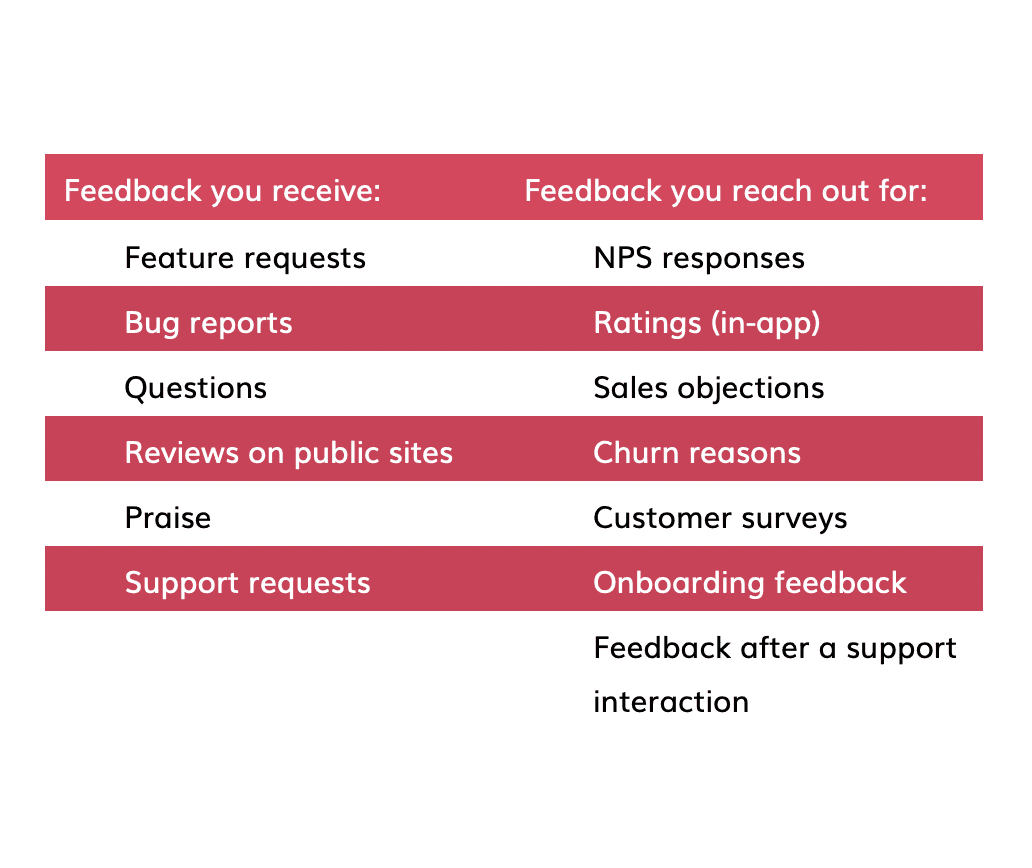Sep 21, 2022
Ferdinand Goetzen
Customer feedback is the lifeblood of an organization’s success. There is pretty much no way anyone can ensure a product’s sustained growth by intentionally excluding their audience from the decision-making process.
NEXT, as a product, relies on feedback to define and prioritize roadmap items, as well as continuously improve existing features. We like to think of it as a surefire way of eliminating bias and assumptions from our decisions.
In this article, we’d like to explore the importance of customer feedback and the insights that stem from it in building a well-rounded product that truly addresses people’s needs.
We’d also like to share with you a story on how we used feedback to refine and improve our transcription feature.
Let’s dive right in, shall we?
Let’s talk about feedback
Customer feedback embodies a broad spectrum of data—often broader than most people expect. We often think of it as being explicit, direct guidance toward improving a product’s offering, but that’s only one side of the coin. There’s also a lot to be learned from people’s behavior while interacting with your website or app.
Businesses should seek to differentiate between inbound and outbound feedback, as well as explore a variety of qualitative and quantitative research methods to get a better understanding understanding of the underlying issues and the context in which they arise.
More importantly, feedback might not always be your starting point. Indeed, sometimes, your users might flag some of the problems they’re facing, but often, product teams are left to their own devices to understand what causes anomalies in the product’s analytics.
Understanding the root causes of a problem is always about striking the right balance between feedback and research data types. For example, your analytics may show you that you have a considerable dip in conversion rates at a certain step of the user journey. One way of addressing this would be to lead a a full-on qualitative investigation to understand what caused it. Your quantitative data flagged an anomaly, and you can use qualitative data to unveil the reasons. There are scenarios in which it can work the other way around.
Balancing types of data and feedback is important because it provides us with a broader and clearer understanding of the situation at hand.

All of these are great sources of valuable direction and planning. When applied correctly, they can help improve your product's user and customer experience, push growth, and skyrocket your revenue.
And why on Earth would you not want to know what the people want? The people who pay money to use your product have practical and very specific ideas about the changes they’d like to see. Refusing to use this information will only impede you from earning more valuable customers.
However, we’d also like to point out that just seeking out and listening to customer feedback is by no means enough, simply because it’s just a raw, unstructured bunch of information.
Imagine that you’re trying to piece together a jigsaw puzzle that also doesn’t have the final image on the box. You dump all of the pieces on the table, and you immediately have a broad idea of what the final result should look like—this is all the feedback you’ve collected. You have a hunch, maybe even assumptions, about what your customers’ needs are, but to truly understand them, time and effort need to be invested into structuring and extracting valuable insights from them.
Piecing things together
Let’s expand on our jigsaw metaphor. How would you go about piecing together a puzzle without understanding what it looks like in its final form? You seek patterns. Customer feedback is fairly similar in this regard—your goal is to identify similarities in the data you extract from feedback and prioritize it based on ease, impact, and confidence (given that you’re following the ICE framework).
We’ve previously published an article about the confidence dimension in the ICE and RICE models—the feedback you gather should guide your product’s evolution.
Analyzing, processing, and making sense of the data you gather is the vehicle for confident and truly customer-led decision-making.
So what is the equivalent of spotting patterns in your customer data? We call them findings and insights
We like to think of findings as the things that stand out in customer feedback, while insights are the actionable direction we extract from them.
The important point about analyzing your data is not to look for averages. You must point your gaze at the extremes of the bell curve. Opinions like, “meh, it’s okay," are not useful when it comes to generating insight—lukewarm reactions won’t take us places.
However, when analyzing your feedback and research data, you’ll often spot many details that point towards the same conclusion. Let’s take a look at a quick look at a series of data points:
Your analytics suggest that 38% of users drop off after the second page of the signup process
You receive feedback from a user that suggests that “there are too many fields in the form, and it takes too long to fill them out."
According to a survey you’ve conducted 70% of our respondents aren’t comfortable with sharing their phone number.
You receive a chat message from a user that mentions that they can’t click the “Next” button on the form.
All of these findings point towards one insight—the signup form can be shortened and improved for better conversions.
How we improved our transcription feature
We created NEXT to help teams and businesses gather a better understanding of their customers. Like any business out there, we sometimes go out on a limb and make assumptions about what the people we serve want and need. This is a brief account of the evolution of our transcription feature and how customer feedback helped us perfect it.
Our transcription functionality is, in fact, a combination of multiple features pieced together—uploading a video, transcribing the video in multiple languages, detecting and assigning speakers, time-stamping speakers, reading along to transcriptions while watching the video, highlighting Findings within the transcription, and so forth.
We were extremely excited before its release because it would help teams upload their interview recordings and get a text-based breakdown of the video. This is very useful when it comes to analyzing research, quoting research participants, and much more.
Soon after the release, feedback started pouring in, and not all of it was positive. Some of our users found that the transcriptions weren’t as accurate in some languages as they would like them to be. Others wanted more flexibility, like being able to read along while watching the video, add timestamps, and export transcriptions, among other things.
We quickly learned the way we envisioned the feature didn’t entirely overlap with our customers’ expectations. For instance, we thought that letting people edit the transcribed text would be a good idea, but what we failed to realize at first was that the transcription technology we used sometimes confused speakers—a scenario we didn’t account for. Some of our earliest feedback had to do with the ability to assign entire paragraphs of text to certain speakers.
At that point, we realized that we had a puzzle to solve, so a large part of our team put their heads together to look for viable improvements to our transcriptions feature.
We collected all the feedback in our NEXT workplace, which we then used to extract 51 findings and two insights.
We like to think of findings as the highlights as the things that stand out in our customers’ feedback, the puzzle pieces that allow us to seek potential solutions. Insights, on the other hand, are the sparks of intuition that help us connect the dots and make informed decisions.
We knew what we had to do. First, we separated the necessary changes into low-hanging fruit—things that we can address quickly and the issues that we need to investigate further.
One of the quick solutions we found was to change our underlying transcription tech, which made a huge difference. We ended up receiving a lot of positive feedback as a result. Some other improvements that we were able to make quickly and relatively effortlessly were allowing users to highlight transcriptions as they were reading along and copying the transcripts, if users needed to delete the video for whatever reason.
We’ve also addressed a fair amount of editability concerns by simply making the transcriptions highly accurate. While we’re still working on expanding the editing functionalities of our transcriptions, we were able to solve a vast amount of customer complaints by making sure that they have pretty much no reason to edit things whatsoever.
However, there are other areas of our customers’ experience that we needed to understand better, which is why we scheduled in-depth outbound interviews with UX researchers to help empathize with them more and make informed and confident improvements to our platform.
Aside from user interviews, we performed a detailed competitor research exclusively on the topic of transcriptions.
This study on improving transcriptions yielded 70 findings, which led to 2 insights, both multiple pages in length.
Interestingly, it has also helped us invalidate some of our assumptions about certain parameters of the feature. For instance, we believed that adding captions to the videos that our customers upload would be a nice touch—that this would be valuable for anyone using the platform. Well, it seems like nobody really cared about it.
We also learned that users really care for things like highlighting text, knowing how much a transcription would take, the ability to assign speakers, and many other things that we took note of and worked restlessly to incorporate into our platform.
The bottom line
Businesses thrive off customer feedback—every single team out there is sitting on a goldmine of insight that can drive their products to success. The critical part is analyzing it and piecing it together into a coherent narrative about customer needs and expectations. Customers are the expert, not the other way around.
Understanding what your customers want is vital for your product's success. Try NEXT to make better sense of your customer insights and data.




